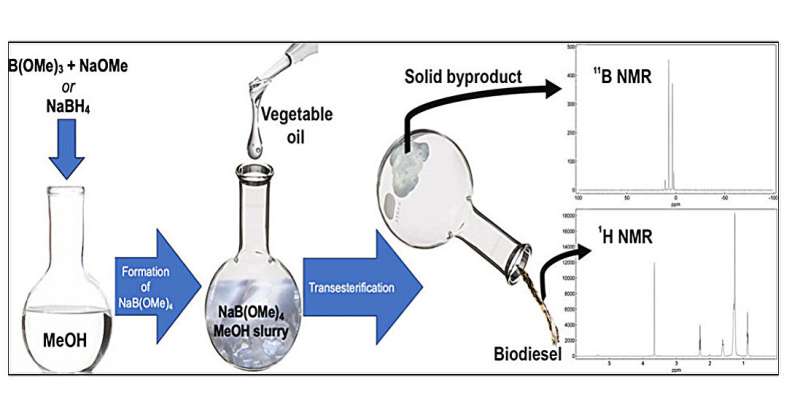UC Santa Cruz chemists have discovered a new way to produce biodiesel from waste oil that both simplifies the process and requires relatively mild heat. This discovery has the potential to make the alternative fuel source much more appealing to the massive industrial sectors that are the backbone of the nation’s economy.
In 2022, the U.S. transportation sector alone used about 3 million barrels of diesel per day, accounting for about 75% of total consumption of the fuel in this country. That same year, diesel use accounted for about 10% of total energy-related CO2 emissions in the United States, according to the federal Energy Information Administration.
While some companies have turned towards electric vehicles to reduce their carbon footprint, the vast majority of fleets still run on diesel—in part, because biodiesel production is difficult, energy intensive, and so, has slowed adoption. Of all the energy sources used by the U.S. transportation sector in 2022, biofuels accounted for just 6%.
In their study, published on October 3 in the journal Energy & Fuels, lead author Kevin Lofgren details a new way to turn used vegetable oil into biodiesel that involves sodium tetramethoxyborate (NaB(OMe)4). This chemical, used to make the active ingredient that reacts with oil to make biodiesel, is considered unique because it allows the biofuel to be easily separated from the byproducts of production—by simply pouring them off.
Another benefit is the resulting byproduct can be used to regenerate the most expensive ingredient in the production process. And last but not least, the reaction can be completed in under an hour at temperatures as low as 40°C (104°F)—saving energy and money.
“I always wanted to work on biodiesel,” said Lofgren, a Ph.D. student in chemistry at UC Santa Cruz. “I started exploring this new material that we made to see if it could attack the fats in oil to help catalyze biodiesel, and it all flowed from there.”
While individual consumers increasingly turn to solar and electric energy to power their homes and vehicles, America’s huge industrial sectors still rely on diesel fuel. Lofgren pointed out that the majority of the trucks, trains, and boats that ship goods around the world currently run on diesel engines and won’t be electrified any time soon.
Meanwhile, the researchers point out, biodiesel is a carbon-neutral fuel that is available today and approved to power these vehicles without the need for engine modifications.

Reducing the energy needed to make biofuel
Some of the current methods for making biodiesel produce soap as a byproduct, which makes purifying the fuel difficult and results in less actual product. Other approaches rely on palm oil, which requires clearing trees in rainforests to make room for monoculture palm tree plantations. These methods are also energy intensive, requiring extremely high temperatures and pressures. The technique detailed in this study can produce biodiesel at a temperature lower than that required to boil water.
“To make energy takes a lot of energy,” said co-author Scott Oliver, professor of chemistry and biochemistry. “Our method uses waste oil and mild heating, compared to current petroleum refineries that are energy consuming and pollution causing.”
According to the researchers, the method they discovered turns about 85% of used vegetable oil into biodiesel and passes almost all industry standards for use as fuel in heavy machinery and transportation vehicles. The exception was water content, though, it was only slightly higher than the acceptable value. The researchers expect that once this process is scaled up, the water content will be within acceptable levels.
“This new method is special because it is simple and affordable. It has the bonus of being able to regenerate the starting material,” Lofgren said. “It’s already low-cost enough to make it competitive. But if you can buy the most expensive ingredient once and then regenerate it, it would be more cost efficient in the long run.”
“Everybody needs energy—every farm, food production plant, and transportation vehicle depend on it,” Oliver said. “This could really impact people. This process can be done at just above room temperature and it’s reusable. You don’t need to have a refinery; you can potentially use this method on a farm.”
Bakthan Singaram, professor of chemistry and biochemistry at UC Santa Cruz, is co-corresponding author of the paper, “Borate Pathway to FAMEs at Near-Ambient Conditions from Used Oil.”
More information:
Kevin C. Lofgren et al, Borate Pathway to FAMEs at Near-Ambient Conditions from Used Oil, Energy & Fuels (2024). DOI: 10.1021/acs.energyfuels.4c03643
Provided by
University of California – Santa Cruz
Citation:
Chemists find easier way to produce biodiesel from waste oil (2024, November 8)
retrieved 8 November 2024
from https://phys.org/news/2024-11-chemists-easier-biodiesel-oil.html
This document is subject to copyright. Apart from any fair dealing for the purpose of private study or research, no
part may be reproduced without the written permission. The content is provided for information purposes only.

